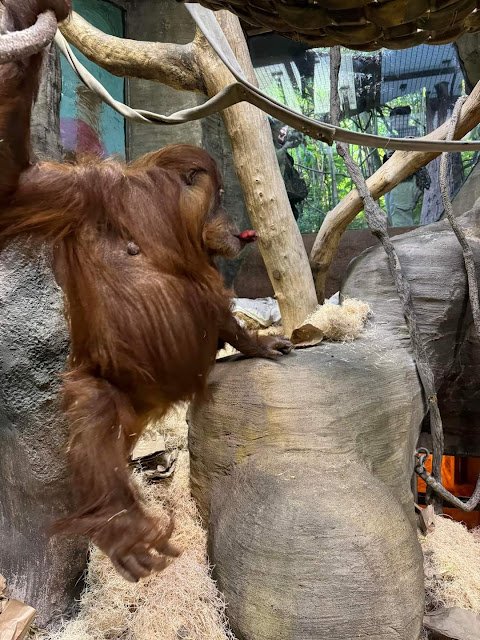Posted by Gigi Allianic, Communication
Editors November 13. November 2024: Hi friends. Many of you have asked about our Sumatran Orangutan Batu and the status of her pregnancy. Here’s an update. You haven’t missed a birth message. Admittedly, our expected birth window was pretty off. Although we do not have a clear new window for her delivery, all other indicators are good: Batu remains healthy, the fetus seems healthy, and Batu gets regular control before the birth of our veterinary staff and weekly control of an obggyn. We continue to send Batu -Positive Vibber as she stays on track. We know you are excited for her baby to arrive and we are too! Again, thank you for checking in and we hope to share some positive baby news very soon!
Calculations of birth window are based on the estrus cycle, physical changes, including weight gain, time for mating and positive pregnancy test results. As a result, it is not possible to precisely predict a particular date of birth, but the recent changes indicate that it is approaching.
 |
| A pregnant batu, photo by Laura McComesky/Woodland Park Zoo |
The birth management plan tailored to orangututans at the Zoo includes a pre- and post-natal care program that includes regular veterinary control in consultation with an obstetrician gynecologist, ultrasound procedures to track fetal development, a diet created by an Ernuty General and supplement vitamins Healthy weight for a delivery without challenges.
As for human women, ultrasonic depiction is non-invasive, painless and safe. Ultrasound procedures are attempted a few times a week at Batu to monitor fetal growth and visualize fetal movements, development and heart function. Ultrasound is made possible through focused training sessions of the Zoo’s Orangutan Care Team, which stems from a trusting relationship between the patient and the carers, but depends on Batus collaboration.
 |
| Batu is due every day now! Photo by Laura McComesky/Woodland Park Zoo |
“Batu gets the choice to voluntarily participate in the non-invasive ultrasonic procedures that involve her presenting her stomach and quietly when we use the ultrasound probation for imaging. Sometimes she is not interested in participating, but we follow her signals,” Dr. Tim Storms, director of Animal Health at Woodland Park Zoo. “We also use a small Doppler device to monitor the fetal heartbeat. We are happy to report that recent ultrasound images indicate that Batu is in the short term and the fetus seems to be developing well with a normal heartbeat.”
Batu, meaning “Rock” in Malaysian, arrived in 2021 from the Philadelphia Zoo. The first time dad-to-be, Goodek, whose name means “sideburns” in Indonesian, arrived in 2017 from Cheyenne Mountain Zoo (Colorado Springs, Colo.). The Sumatran orgutans were paired during a breeding recommendation of the orangutan arts survival plan and have been companions in the Zoo’s Trail of Vines. Art survival plans are collaborative programs across accredited zoos to ensure healthy, self -supporting populations of endangered and endangered species.
Through batus pregnancy, the Orangutan Care team has provided training in mother skills to help equip her with as many skills as possible to fit confidence and help her be a successful mother.
Female orangutans feed only every seven to nine years, which is an unusually long birth interval for a mammal. Among the great monkeys (orangututans, gorillas, chimpanzees, bonobos and humans), infant’s orangututans have the longest infant development period. They are completely dependent on their mother for the first three to four years while they are carried out and carried by their mothers. Mother orangutans become empty nesters when their babies reach about 7 to 8 years old.
 |
| Godek and Batu, Photo by Jeremy Dwyer-Lindgren/Woodland Park Zoo |
Zoo currently has four orangutututans living in two family groups: Batu and Gyrek share a habitat, while the 35-year-old male Heran and 43-year-old female Belawan (Bela) live in the other orangutanhabitat. Heran was the last orangutan born in Woodland Park Zoo in 1989; His parents have since died.
There are three species of orangututans found only in Southeast Asia: the Corny orangutan resident on the island of Borneo, and Sumatran and Tapanuli Orangutans resident in the island of Sumatra. A critically threatened species, orangututans belong to the Hominidae family, which includes all five major monkeys: gorillas, chimpanzees, bonobos, orangututans and people.
Orangututans face threats, including loss of habitats and fragmentation due to forest fires, logging and conversion to unsustainable monocultures, such as palm oil plantations. Habitat losses are also expected to be worsened with climate change. In addition, these animals are illegally hunted after meat and in response to conflict with humans-Wildlife.
 |
| Batu and Goodek on traces of vines. Photo by Jeremy Dwyer-Lindgren/Woodland Park Zoo |
